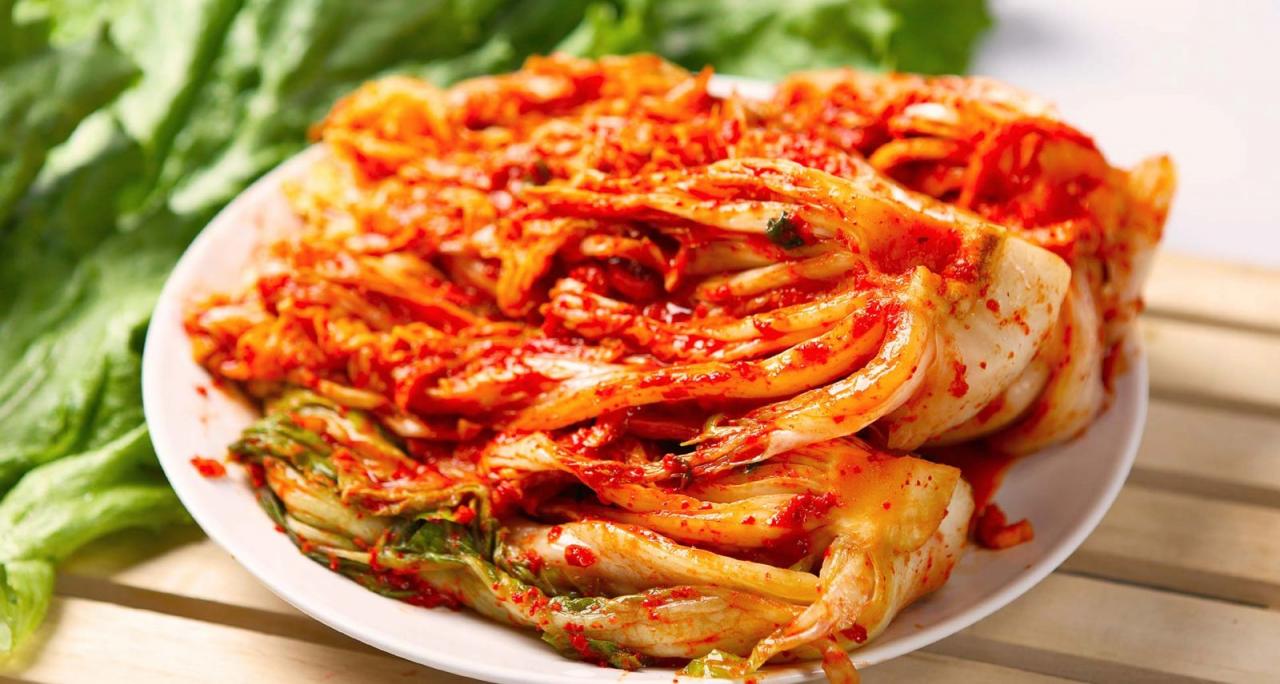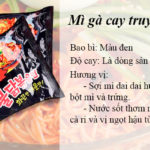Before getting into the process, let’s find out what Kimchi is.
– What is Kimchi?
Kimchi is a spicy Korean dish made from fermented vegetables, typically cabbage and radishes. It gets its unique flavor from a blend of chili powder, garlic, ginger, red pepper, sugar, and the recognizable aroma of fish sauce. While you may be familiar with the most common version, kimchi made with napa cabbage, there are actually over 100 different varieties of this classic dish, including ones made with radishes, cucumbers, and other types of root vegetables…

– When did Kimchi first appear?
According to historical records, kimchi dates back to the Three Kingdoms period of Korea (37 BC – 7 AD). However, kimchi did not obtain its characteristic red color until around the 16th century.
– What does Kimchi mean in Korea?
Kimchi is a way of life in Korea – the numbers don’t lie – 1.5 billion tons of kimchi are consumed in this Asian country each year. Kimchi-making recipes are passed down through generations, and most Korean families have a dedicated refrigerator temperature control specifically for their kimchi. This dish is not only eaten on its own but is also found in countless Korean dishes, including kimchi buchimgae (green onion pancake), ramen, kimbap (seaweed rice roll), braised mackerel, dumplings, and fried rice.
Every year in November, the entire country starts the kimchi-making season, preparing the saltwater brine for the kimchi fermentation process. This tradition has earned them a spot on UNESCO’s Intangible Cultural Heritage of Humanity list and is celebrated with numerous festivals, such as the Seoul Kimchi Making & Sharing Festival.

Popular types of Kimchi
In Korean, Kimchi means “pickled vegetables,” specifically referring to pickles made using the fermentation method (not vinegar).
Similar to Vietnamese pickled vegetables or Japanese tsukemono, kimchi can be made from various vegetables such as cabbage, zucchini, radish, cucumber, beetroot, green onion, coriander, sesame leaves, dandelion, pear, apple, etc. It is safe to say that Koreans can make kimchi from any type of vegetable.
Let’s list some common types of kimchi in Korea.
Baechu-kimchi (Cabbage Kimchi)
This is the type of kimchi we are making in this article. Baechu kimchi is also the most common type of kimchi in Korea, Vietnam, and the world.
Its most outstanding feature is made from napa cabbage marinated with a special blend of seasoning sauces, with the distinctive red color coming from chili powder, the aroma from fermented shrimp, and various types of vegetables.
As mentioned above, Baechu kimchi can be eaten as a side dish or used as an ingredient in many other dishes.

Baechu-geotjeori (Fresh Kimchi)
Also known as fresh kimchi because it is made before it is fermented. At this stage, the kimchi does not have the characteristic sour taste yet, but it is slightly salty, sweet, and fragrant with a fresh, crunchy texture.
After mixing the napa cabbage kimchi, you can simply sprinkle some roasted sesame seeds on top to create Baechu-geotjeori. It’s like a salad, great to eat with rice, grilled meat, or Korean-style stews.
Bossam-kimchi (Wrapped Kimchi)
Also known as Bo-kimchi. “Bossam” means wrapped. Bossam kimchi originated from Gaeseong, in Gyeonggi Province bordering North Korea.
Inside each layer of cabbage, bossam kimchi contains precious seafood (octopus, oysters, abalone, etc.), various seeds, and medicinal herbs, such as pine nuts, chestnuts, mung beans, and ginseng, along with many other delicious vegetables.

Baek-kimchi (White Kimchi)
“Baek” means white.
White kimchi is different from regular kimchi as it does not contain chili powder. Its taste is milder, and the vegetables inside tend to be sweeter and less pungent in flavor.
White kimchi retains the special flavor of kimchi without the spiciness, making it suitable for children, the elderly, and those who dislike spicy food. Enjoying bossam (steamed pork wrapped in napa cabbage and Korean-style seasonings) with white kimchi is a delightful experience.

Yangbaechu-kimchi (Radish Kimchi)
Yangbaechu means radish. Kimchi made from radish is also extremely delicious and is often considered a fast kimchi.
While traditional kimchi-making usually involves salting and folding whole cabbage leaves, with radish kimchi, you only need to thinly slice the radish and mix it evenly with the kimchi seasoning sauce. The salting process for the radish is also shorter compared to cabbage.
Radish has a natural sweetness and a crisp texture similar to napa cabbage. If you put effort into seasoning, radish kimchi can be just as delicious as napa cabbage kimchi.

Dongchimi (Winter Kimchi)
“Dongchimi” means kimchi (chimi) in winter (dong). It is named so because radishes, the main ingredient of dongchimi, are harvested in late autumn when they are firm, crispy, and sweetest.
Dongchimi is also a representative of the watery type of kimchi. Whole radishes or large pieces of radish are salted in a diluted saltwater solution, along with ginger, garlic, chili, green onions, and pears, until they become slightly sour and edible. It is quite similar to Vietnamese pickled turnips.
When eating, Koreans cut the radishes into small pieces, place them in a bowl, and pour the dongchimi brine over them. The water is light, tangy, and drinkable, and can be used to make cold noodle soup or enjoyed on its own.
Nabak-kimchi (Thinly Sliced Kimchi)
“Nabak” originates from “nabaknabak,” which means thinly sliced. Alternatively, you can call it oi-kimchi, which means kimchi made with sliced cucumbers.
Cucumbers are split almost in half, spread out like flowers, and the kimchi seasoning sauce is applied to the cucumber slices along with various vegetables. Nabak kimchi is similar to a sweet and refreshing cucumber salad, so it is best to enjoy it as soon as it is made to maintain its freshness. It is not recommended to let it sit or cook it like napa cabbage kimchi.

Pa-kimchi (Green Onion Kimchi)
In addition to types of kimchi made from white vegetables (napa cabbage, radish), kimchi made from green vegetables is also highly preferred in the land of “Oppa” (referring to a Korean man). The first type to mention is green onion kimchi.
Here, green onion refers to the small-sized green onion, not the large ones used for grilling. Vietnam has fresh and yummy green onion all year round, and it’s affordable; it’s just perfect for this dish. Green onion kimchi is popular in Jeolla Province, located in the southwestern part of Korea.
Its seasoning is also similar to napa cabbage kimchi. You don’t need to add any additional vegetables because the green onion itself is already flavorful, sweet, and crunchy. Consuming one whole green onion kimchi with seafood pancakes (kimchi jeon), for example, is delicious.

Yeolmu-kimchi (Young Radish Leaf Kimchi)
Yeolmu is also known as young radish or trumpet creeper. Sometimes, you can find green radishes with small white roots at the markets; Vietnamese people also salt the whole radish, just like in yeolmu kimchi.
After fermentation, the pungent flavor of the radish is harmonized with the kimchi seasoning sauce, creating a delicious and attractive dish. In Vietnam, it’s easy to find green radishes at every market. Whenever you get bored with napa cabbage kimchi, you can try yeolmu kimchi.
Gat-kimchi (Mustard Leaf Kimchi)
In Vietnam, there are many types of leafy mustard greens referred to as “gai choy”. The mustard greens used in this kimchi have more leaves, longer stems, and are quite large in size, different from the giant Chinese mustard greens. In Korea, children who aren’t yet of marriageable age often have braids, like the stems of these green mustard leaves.
In the case of making kimchi, you should choose the strong and heavy braid. The leaves of the mustard greens should not have fading spots, and the stems should not be dented or rotten. If you find any, make sure to clean them properly during the preparation process.

It’s true that you can make kimchi using any type of vegetable!
In this article, I will provide the steps to make traditional Korean kimchi. I hope you enjoy making this delicious dish for your family meals. Kimchi tastes the best when it is served with hot rice.
Good luck!






































